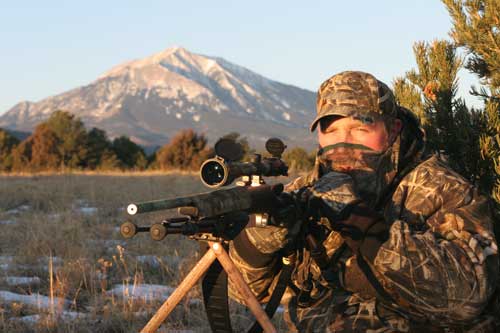 Wolf hunting opportunities are opening up all across the country with seasons in at least six states this fur season. Of course anti-wolf hunting advocates will be using the courts wherever possible to put up roadblocks to science-based management, but that's a gamble hunters face each season.
Wolf hunting opportunities are opening up all across the country with seasons in at least six states this fur season. Of course anti-wolf hunting advocates will be using the courts wherever possible to put up roadblocks to science-based management, but that's a gamble hunters face each season.
Are you on the hunt for one of America's most unique predator trophies? If so you'll want to formulate a strategy. Wolves may be big canines like their cousin the coyote, but they do have some distinct character and behavior differences. If you ignore these you could missing out on some great wolf action. Last year, in an effort to help hunters tag more wolves, the Rocky Mountain Elk Foundation (www.rmef.org) released a poll on some of the best hunting tips their members offered to increase wolf-hunting success. I've listed them below along with some notes for those of you hunting wolves miles from core elk areas.
Top 10 Wolf Hunting Tips from RMEF Members
1. Stay close to elk. If you can find a herd of elk, especially a herd a mile or more from a road, it's just a matter of time before wolves show up. NOTE: For those of you hunting wolves east of the Mississippi consider hunting near whitetail yarding areas and don't overlook livestock owners experiencing conflicts.
2. Wolves can be patterned like other game. Scouting will help you find travel routes, crossings, etc. Wolves tend to take the easy paths: roads, trails and frozen lakes. NOTE: Many Canadian outfitters routinely call or bait wolves onto open ice for increased visibility on reclusive wolves.
3. Get hunting permission from private landowners. Lots of landowners are happy to have wolf hunters. It could lead to other hunting opportunities down the road, too.
4. Most wolf hunters want to shoot a big trophy male. But taking females is better for population control. The main thing is just don't shoot a collared wolf. Collars are needed to track the packs — and funding for collaring wolves is getting tighter.
5. Go on more hunts specifically for wolves, not for wolves as a byproduct of another hunt. (Questionnaire data reveal only 11 percent of respondents hunted exclusively for wolves; most hunted for wolves as part of a deer or elk hunt.)
6. Howling works to locate wolves. But too much howling, especially by inexperienced callers, can educate wolves. Elk calf and fawn-in-distress and coyote calls work well. Also try moose calls. NOTE: In Great Lakes regions whitetail-in-distress calls imitate a main prey species in peril.
7. When calling, set-up on high ground, not in a hole or depression. Visibility is a key. Consider using a blind. Wolves seem to spot blaze orange from a great distance. NOTE: A treestand also increases your ability to see, plus it can disperse your scent higher to eliminate a wolf smelling you.
8. Wolves are more reckless in their pursuit of prey when it's colder outside. Hunters should concentrate on bad weather days for wolf hunting.
9. Watch for birds — magpies, gray jays, ravens — as a tipoff to fresh kill locations. Approach carefully and watch the area for returning wolves. Consider using a treestand. A driving technique with a group of hunters also can work.
10. Once you kill a wolf, stay put. Other wolves from the pack often return to the site, sometimes very quickly. You (if regulations allow for two wolves) or a buddy may get a chance at a second wolf.
Are you looking for more wolf-hunting information? Follow this link for additional information and insights compiled by the RMEF.
Wolf hunting opportunities are increasing, but these pack animals represent a different challenge than many of you are used to from coyote or bobcat pursuits. Brush up on your wolf strategies to brush out the pelt on a prime wolf this coming season. If you have any other great strategies to share with your wolf hunting peers, please add them to the comment section below.






